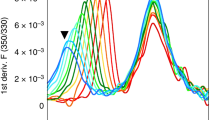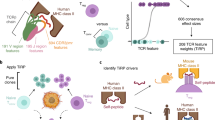Abstract
CLASS I molecules of the major histocompatibility complex (MHC) transport peptides to the cell surface for surveillance by T cells1. Ligand specificity is stringent and differs from allele to allele2–4. Here we report analysis of natural ligands of 'unconventional' glycophosphatidyl-anchored mouse class I molecules, Qa-2. The function of these molecules is unclear5–6; they can serve as recognition structures for 'unrestricted' cytotoxic T cells but have not been found to present peptides to T cells, although the DNA sequence suggests a similar peptide binding groove to that of 'conventional' class I molecules7, and other unconventional class I molecules can present antigens in a few cases8–10. Pool sequencing of natural Qa-2 ligands shows that Qa-2 molecules are indeed peptide receptors, having ligand specificity similar to that of conventional class I molecules, that is, a predominant length of nine amino acids, anchor positions, and hydrophobic termination of peptides. But ligand specificity is much more stringent than with other class I molecules: of the nine positions, two are anchors and four have rather limited occupancy.
This is a preview of subscription content, access via your institution
Access options
Subscribe to this journal
Receive 51 print issues and online access
$199.00 per year
only $3.90 per issue
Buy this article
- Purchase on Springer Link
- Instant access to full article PDF
Prices may be subject to local taxes which are calculated during checkout
Similar content being viewed by others
References
Rötzschke, O. & Falk, K. Immun. Today 12, 447–455 (1991).
Falk, K., Rötzschke, O., Stevanovic, S., Jung, G. & Rammensee, H.-G. Nature 351, 290–296 (1991).
Jardetzky, T. S., Lane, W. S., Robinson, R. A., Madden, D. R. & Wiley, D. C. Nature 353, 326–329 (1991).
Hunt, D. F. et al. Science 255, 1261–1263 (1992).
Flaherty, L., Elliott, E., Tine, J. A., Walsh, A. C. & Waters, J. B. CRC Crit. rev. Immun. 10, 131–175 (1990).
Mellor, A. L. et al. Int. Immun. 3, 493–502 (1991).
Bjorkman, P. J., Saper, M. A., Samraoui, B., Bennett, W. S., Strominger, J. L. & Wiley, D. C. Nature 329, 506–512 (1987).
Vidovic, D., Roglic, M., McKune, K., Guerder, S., MacKay, C. & Dembic, Z. Nature 340, 646–650 (1989).
Loveland, B., Wang, C. R., Yonekawa, H., Hermel, E. & Lindahl, K. F. Cell 60, 971–980 (1990).
Milligan, G. N., Flaherty, L., Braciale, V. L. & Braciale, T. J. J. exp. Med. 174, 133–138 (1991).
Sharrow, S. O., Arn, J. S., Stroynowski, I., Hood, L. & Sachs, D. H. J. Immun. 142, 3495–3502 (1989).
Soloski, M. J., Hood, L. & Stroynowski, I. Proc. natn. Acad. Sci. U.S.A. 85, 3100–3104 (1988).
Rudensky, A. Y., Preston-Hurlburt, P., Hong, S. C., Barlow, A. & Janeway, C. A. Nature 353, 622–627 (1991).
Hasenkrug, K. J., Cory, J. M. & Stimpfling, J. H. Immunogenetics 25, 136–139 (1987).
Hermel, E., Grigorenko, E. & Lindahl, K. F. Ing. Immun. 3, 407–412 (1991).
Monaco, J. J. Immun. Today 13, 173–179 (1991).
Madden, D. R., Gorga, J. C., Strominger, J. L. & Wiley, D. C. Nature 353, 321–325 (1991).
Saper, M. A., Bjorkman, P. J. & Wiley, D. C. J. molec. Biol. 219, 277–319 (1991).
Fremont, D. H., Matsamura, M., Stura, E. A., Peterson, P. A. & Wilson, I. A. Science 257, 919–927 (1992).
Shawar, S. M., Vyas, J. M., Rodgers, J. R., Cook, R. G. & Rich, R. R. J. exp. Med. 174, 941–944 (1991).
Kurlander, R. J., Shawar, S. M., Brown, M. L. & Rich, R. R. Science 257, 678–679 (1992).
Pamer, E. G., Wang, C.-R., Flaherty, L., Fischer Lindahl, K. & Bevan, M. J. Cell 70, 215–223 (1992).
Darlington, G., Bernhard, H., Miller, R. & Ruddle, F. J. natn. Cancer Inst. 64, 809–819 (1990).
Miller, J. & Germain, R. J. exp. Med. 164, 1478–1489 (1986).
Allison, J. P. & Havran, W. L. A. Rev. Immun. 9, 679–705 (1991).
Hershberg, R. et al. Proc. natn. Acad. Sci. U.S.A. 87, 9727–9731 (1990).
Wu, M., Van Kaer, L., Itohara, S. & Tonegawa, S. J. exp. Med. 174, 213–218 (1991).
Author information
Authors and Affiliations
Rights and permissions
About this article
Cite this article
Rötzschke, O., Falk, K., Stevanović, S. et al. Qa-2 molecules are peptide receptors of higher stringency than ordinary class I molecules. Nature 361, 642–644 (1993). https://doi.org/10.1038/361642a0
Received:
Accepted:
Issue Date:
DOI: https://doi.org/10.1038/361642a0
Comments
By submitting a comment you agree to abide by our Terms and Community Guidelines. If you find something abusive or that does not comply with our terms or guidelines please flag it as inappropriate.



